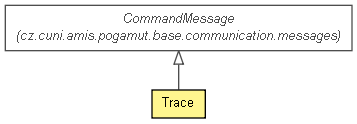 cz.cuni.amis.pogamut.base.communication.messages.CommandMessage
cz.cuni.amis.pogamut.base.communication.messages.CommandMessage
 cz.cuni.amis.pogamut.ut2004.communication.messages.gbcommands.Trace
cz.cuni.amis.pogamut.ut2004.communication.messages.gbcommands.Trace
|
|||||||||
| PREV CLASS NEXT CLASS | FRAMES NO FRAMES | ||||||||
| SUMMARY: NESTED | FIELD | CONSTR | METHOD | DETAIL: FIELD | CONSTR | METHOD | ||||||||
java.lang.Objectcz.cuni.amis.pogamut.base.communication.messages.CommandMessage
cz.cuni.amis.pogamut.ut2004.communication.messages.gbcommands.Trace
public class Trace

Representation of the GameBots2004 command TRACE. Will send a ray from specified location to specified destination, responds with TRC message. TRACE uses Trace function - slower then FastTrace function, but provides more information about collision.
| Field Summary | |
|---|---|
protected Location |
From
Origin point of the ray. |
protected java.lang.String |
Id
Message Id made up by you and echoed in response so you can match up response with query. |
static java.lang.String |
PROTOTYPE
Example how the message looks like - used during parser tests. |
protected Location |
To
Target point of the ray. |
protected java.lang.Boolean |
TraceActors
When true it means that all actors will be traced – for example players, bots, monsters, items etc. |
| Constructor Summary | |
|---|---|
Trace()
Creates new instance of command Trace. |
|
Trace(java.lang.String Id,
Location From,
Location To,
java.lang.Boolean TraceActors)
Creates new instance of command Trace. |
|
Trace(Trace original)
Cloning constructor. |
|
| Method Summary | |
|---|---|
Location |
getFrom()
Origin point of the ray. |
java.lang.String |
getId()
Message Id made up by you and echoed in response so you can match up response with query. |
Location |
getTo()
Target point of the ray. |
java.lang.Boolean |
isTraceActors()
When true it means that all actors will be traced – for example players, bots, monsters, items etc. |
Trace |
setFrom(Location From)
Origin point of the ray. |
Trace |
setId(java.lang.String Id)
Message Id made up by you and echoed in response so you can match up response with query. |
Trace |
setTo(Location To)
Target point of the ray. |
Trace |
setTraceActors(java.lang.Boolean TraceActors)
When true it means that all actors will be traced – for example players, bots, monsters, items etc. |
java.lang.String |
toHtmlString()
|
java.lang.String |
toMessage()
|
java.lang.String |
toString()
|
| Methods inherited from class java.lang.Object |
|---|
clone, equals, finalize, getClass, hashCode, notify, notifyAll, wait, wait, wait |
| Field Detail |
|---|
public static final java.lang.String PROTOTYPE
protected java.lang.String Id
protected Location From
protected Location To
protected java.lang.Boolean TraceActors
| Constructor Detail |
|---|
public Trace(java.lang.String Id,
Location From,
Location To,
java.lang.Boolean TraceActors)
Id - Message Id made up by you and echoed in response so you can
match up response with query.From - Origin point of the ray. If you won't support From
attribute, current bot location will be taken as From.To - Target point of the ray.TraceActors - When true it means that all actors will be traced – for
example players, bots, monsters, items etc. in a game. With
TraceActors false we trace just level geometry.public Trace()
public Trace(Trace original)
original - | Method Detail |
|---|
public java.lang.String getId()
public Trace setId(java.lang.String Id)
public Location getFrom()
public Trace setFrom(Location From)
public Location getTo()
public Trace setTo(Location To)
public java.lang.Boolean isTraceActors()
public Trace setTraceActors(java.lang.Boolean TraceActors)
public java.lang.String toString()
toString in class CommandMessagepublic java.lang.String toHtmlString()
public java.lang.String toMessage()
|
|||||||||
| PREV CLASS NEXT CLASS | FRAMES NO FRAMES | ||||||||
| SUMMARY: NESTED | FIELD | CONSTR | METHOD | DETAIL: FIELD | CONSTR | METHOD | ||||||||